The Art of the Camera: An Experimental “Movie”
(Arts and Decoration 1921)
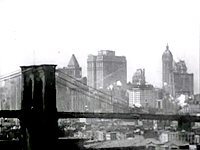 |
|
A few weeks ago the Rialto exhibited a short series of motion pictures of New York.
These motion pictures were the work of Charles Sheeler and Paul Strand, two American artists. Sheeler is well-known as one of our modern painters whose works are in the collections of discriminating connoisseurs and galleries. He is also a photographer of great distinction—an artist in photography. Strand is likewise a master in photography, an experimenter and a pioneer in this youngest of the arts.
In entering the field of the motion picture, Sheeler and Strand sought to apply the technical knowledge gained from their experiments and achievements in “still” photography to the more complex problem of the motion picture—“to register through conscious selection and space-filling those elements which are expressive of the spirit of New York, of its power and beauty and movement.”
| Sheeler and Strand give us the vision of Whitman in plastic poetry, viewed always from unsuspected points of vantage. | |
The results have fully justified this daring adventure in a new art. Short as this film was in the showing, it suggested all sorts of glorious possibilities in the development of the movies. It was not merely artistically satisfying. It was a great stimulus to thought. At a time when our motion picture critics are shouting the praises of Dr. Caligari and the rest of the German importations, it is strange that they should neglect such a significant achievement as this one of two American artists. But perhaps these critical gentlemen can register only the merits of imported art and of the demerits of domestic.
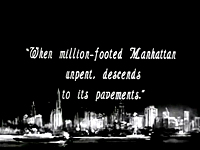 |
In spite of this critical apathy, the Sheeler–Strand pictures mark a turning point in the development of the art of the camera. The direct, expressive, unashamed photography, the salient selection and discrimination by which these “camera men” managed, with the most effective economy, to capture the very spirit of lower Manhattan, the eloquent silence of these brief “shots,” all lead one to claim that in the hands of such craftsmen the camera becomes truly an instrument of great art.
~
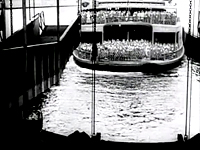 |
|
Such pictures possess that uncanny power of awakening and kindling our interest in that neglected beauty that crowds in upon us from all sides, and through which too many Americans walk with blind and unseeing eyes. It is always the exalted function of the true artist to make us see things through his eye, to reveal beauties undiscovered. In the fulfillment of this mission, he legitimatizes the means at his disposal. And so the camera of Sheeler and Strand dramatizes such a commonplace routine event as the entrance of a Staten Island ferryboat into the South Ferry slip, with its crowd of commuters suddenly released into the streets of lower Manhattan. The docking of the Aquitania, surrounded by those busy Lilliputian tugs; the pencil-like office buildings stretching upwards for a place in the sun—“High growths of iron, slender, strong, splendidly uprising toward clear skies.”
They give us the vision of Whitman in plastic poetry, viewed always from unsuspected points of vantage: the restless crowds of lower Broadway, for instance; view from balustrades hundreds of feet above; plumes of silvery smoke and steam; curious geometry of massive shadows and sharp sunlight; the molten silver of surging waters at dusk; all that dynamic power and restless energy of the metropolis. All of these were captured in the motion photography of the American artists.
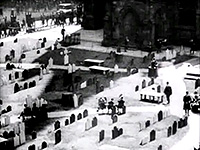 |
|
There was no heroine, no villain, no plot. Yet it was all thrilling, exciting, dramatic—but dramatic in the language of plasticity. It was honestly, gloriously photographic, devoid of trickery and imitation. They used no artifice of diffusion. They did not resort to the aid of the soft-focus lens. They did not attempt to make pictures that looked like paintings. They did not “retouch” to produce the effect of a spurious etching. Always were they vigorously, rigorously, photographic. These artists avoided the well-known “points of interest.” Instead, they gave us, by a brilliant emphasis of its own way of speaking, the spirit of Manhattan itself, Whitman's “city of the world,” Whitman's “proud and passionate city.” The city, they discovered, reveals itself most eloquently in the terms of line, mass, volume, movement. Its language is plastic. Thus it expresses its only true individuality.
How does this experiment, this glorious adventure, differ from the ordinary movie? It emphasizes anew the art of the camera. Properly understood and used intelligently, the motion picture camera, like the ordinary camera, becomes an invaluable instrument, registering the vision of the creative artist. With it he is endowed with a new power of capturing on the wing, as it were, all that fleeting and evanescent beauty of places and people. At last the artist can register those strange accidental moments when light, lines, form and movement seem by chance to combine into an unearthly divine beauty, transmuting every-day objects into plastic poetry.
| Photography still remains the Cinderella of arts. . . . Perhaps the time is far distant when photography may be taught in the schools, or schools of photography as an art established and endowed. | |
Of course, there are complex difficulties, obstacles almost impossible to overcome. But to dismiss the camera as a mere “machine,” to deny it a place in the realm of legitimate art, is to cast away forever the possibility of discovering its latent potentialities and secrets. But to accept it, as these American artists have, with respect and reverence, to use it as an instrument of art, is to acquire the key to a vast and unexplored treasure house of expression. A comparison with another art may illuminate this point. Both for the creation and the interpretation of great music we accept without question the legitimacy of the musical instrument. The piano of a Chopin, the ’cello of a Casals, the violin of a Kreisler, are never considered as “music machines.” In the hands of a Sheeler the camera should likewise be accepted as an instrument of art, objectifying the creative vision of the artist. The difference between the camera and the musical instrument is a difference in degree, not in kind.
~
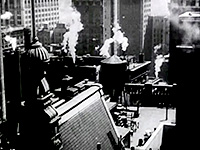 |
|
Photography still remains the Cinderella of arts. Once its legitimacy is recognized, once we awaken to the urgent duty of developing its latent potentialities, it may become an essential in any adequate art-education. Perhaps the time is far distant when photography may be taught in the schools, or schools of photography as an art established and endowed. Mr. Eastman, we read, has endowed a music school in Rochester. Might he not, with singular appropriateness, likewise establish a school of photography through which the art of the camera might be elevated to its legitimate place among the arts?
~
The Sheeler-Strand experiment brings up another question. Is there no place in the motion picture world, as organized at present, for such pioneering experiments? At least two answers to this question have been offered.
| In an art in which the studio and laboratory costs are so high, it is to be doubted whether the experimenter could ever attain even the technical excellence of the professional producers. And without this excellence the experiment would fail. | |
The first is that there should be a “little movie” movement, paralleling the so-called “little theatre” movement, which has a beneficial influence upon native American drama, releasing new talents, and demonstrating that the public will support worthy plays. In the field of the motion picture, such a movement might take the form of a small producing group of directors, scenarists, actors and photographers.
The “release” of a film produced in this manner might be effected through the regular exhibitors. Or it might be shown in theatres especially rented for that purpose. In either case the expense would be enormous and the profits small. In view of the uncertainty of results, the almost insuperable obstacles in the way of any widespread exhibition, this plan is hardly feasible. In an art in which the studio and laboratory costs are so high, it is to be doubted whether the experimenter could ever attain even the technical excellence of the professional producers. And without this excellence the experiment would fail.
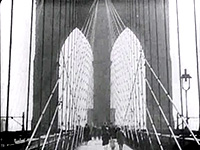 |
|
The second suggestion is the organization by the most firmly established and reputable producers of a research or experimental department, in which true artists of the camera would be free to carry out their adventures and experiments. Occasionally, perhaps often, they would attain results that might be used with the greatest artistic benefit in the regular productions. In this way the art of the motion picture would be developed from within.
A great variety of methods might be attained. And instead of submitting every scenario to one cut-and-dried method, each picture would be screened in a highly individual and novel manner. It might then be interpreted in a manner best suited to the realization of its values.
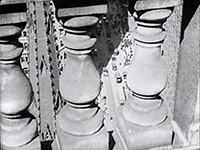 |
|
Such a research department would eventually do away with the hit-and-miss methods at present employed. It would in time prevent the enormous waste of effort, the conspicuous expenditure on non-essentials, of which the press-agents now, for some strange reason, actually boast. All the inherent powers of the motion picture camera might thus be developed into eloquent expression, and the motion picture industry would be assured of continuous novelty and artistic vitality. The lamentable evidences of repetition, imitation and conventionalization would disappear.
If it be objected that such a suggestion is wildly idealistic and “highbrow,” we need in reply only point to the example set by other highly successful industries and commercial organizations. Professor Soddy, the great English authority on radio-activity, recently declared that the department of scientific research established by the General Electric Company was doing more for pure science than the majority of British universities. Such a department, based on far-sighted commercial policy, is recognized as essential to the health and growth of the electrical industries.
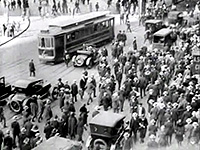 |
|
A similar department, we are informed, is supported by the Bell Telephone system. In the more immediate field of the industrial art, we may point to the eminent example of one of our foremost manufacturers of American silks.
The Cheney Brothers Company have long supported an experimental studio, in which a staff of artists, designers and weavers are given the freedom to pursue unhindered their artistic adventures in the realm of design. There are no directions, no prohibitions, no insistence upon turning out work that may be immediately gauged in terms of dollars and cents. In this fashion the art standards are upheld and the public is assured of the artistic quality of the finished product.
~
An insane passion for immediate profit in any industry may in the long run become the most unprofitable of policies. And it is precisely this mad passion that has worked to the detriment of the motion picture. The geese that lay the golden eggs are beginning to rebel. Millions have been spent, often unwisely and without appreciable result. The “camera men,” who really hold the strategic key to the situation, are only beginning to be recognized. Few directors have the “camera” sense.
Light too often is used merely as a necessary evil, when it should be used to enhance and vitalize the movement. When the producers awaken to the fact that the “camera men” must be artists of intelligence and discrimination, educated and efficient in their craft, the art of the motion picture will attain its maturity.
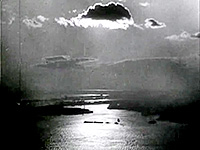 |
Without this co-operation of science and art, no permanent progress in the field of the motion picture can ever be effected. A far-sighted policy, looking not merely to immediate profits, nor resting on the miraculous success of the past, must recognize and protect the new art of the camera. Once this Cinderella of the arts is recognized by our Princes of the Celluloid, the latter may discover the only true way in which motion pictures may become not merely more artistic, but more popular and profitable as well. ![]()
Contributor’s Notes: Robert Allerton Parker
Manhatta Suite Introduction
The Art of the Camera: An Experimental “Movie”
Manhatta ![]()